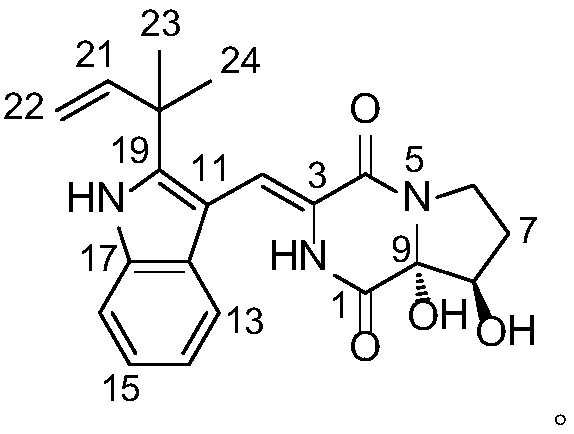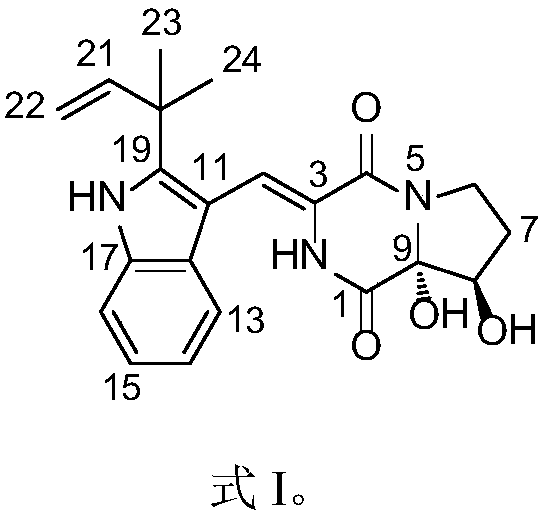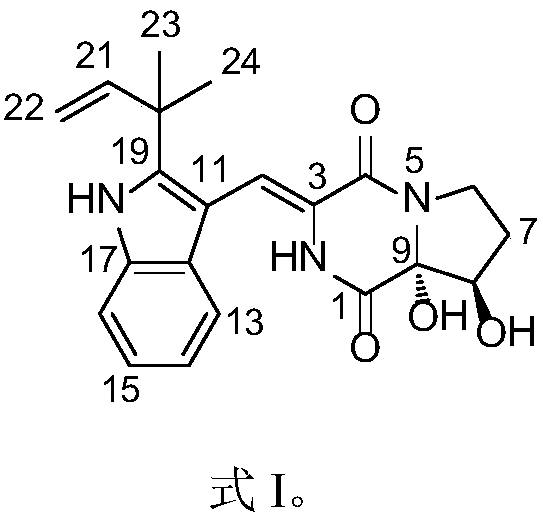Application of novel secondary metabolite LW-4 of aspergillus terreus SKL-001
A secondary metabolite, LW-4 technology, applied in the field of medicine, can solve the problem of not obvious inhibitory activity of Gram-negative bacteria, achieve the effect of improving the extraction rate of fermentation products and accelerating the release of intracellular substances
- Summary
- Abstract
- Description
- Claims
- Application Information
AI Technical Summary
Problems solved by technology
Method used
Image
Examples
Embodiment 1
[0020] The purposes of the new secondary metabolite LW-4 of Aspergillus terreus SKL-001, the new secondary metabolite LW-4 is the compound shown in formula I, its stereoisomer or pharmaceutically accessible salt, the chemical structure formula is :
[0021]
[0022] The application of the new secondary metabolite LW-4 of Aspergillus terreus SKL-001, the preparation method of the new secondary metabolite LW-4 includes strain fermentation, secondary metabolite extraction and separation and purification, the specific steps are:
[0023] Strain fermentation: add the epigenetic modification regulator SAHA to the fungal medium with a final concentration of 15 μM, 0.05% paricalcitol, 0.1% triglyceride, stir evenly, let stand, and ferment for 30 days; Paricalcitol Calciferol and triglyceride are added to the fungal culture medium, which can act synergistically with the epigenetic modification regulator SAHA to change the dissolved oxygen environment in the culture medium, promote m...
Embodiment 2
[0027] The purposes of the new secondary metabolite LW-4 of Aspergillus terreus SKL-001, the new secondary metabolite LW-4 is the compound shown in formula I, its stereoisomer or pharmaceutically accessible salt, the chemical structure formula is :
[0028]
[0029] The use of the new secondary metabolite LW-4 of Aspergillus terreus SKL-001, the preparation method of the new secondary metabolite LW-4 includes strain fermentation, secondary metabolite extraction and separation and purification, the specific steps are:
[0030] Strain fermentation: add the epigenetic modification regulator SAHA to the fungal culture medium with a final concentration of 10 μM, 0.08% paricalcitol, and 0.1% triglyceride, stir evenly, let stand, and ferment for 30 days;
[0031] Extraction of secondary metabolites: After the fermentation is completed, separate the mycelium and the fermentation broth with silk cloth; add an equal volume of ethyl acetate to the fermentation broth and stir and extra...
Embodiment 3
[0034]The purposes of the new secondary metabolite LW-4 of Aspergillus terreus SKL-001, the new secondary metabolite LW-4 is the compound shown in formula I, its stereoisomer or pharmaceutically accessible salt, the chemical structure formula is :
[0035]
[0036] The application of the new secondary metabolite LW-4 of Aspergillus terreus SKL-001, the preparation method of the new secondary metabolite LW-4 includes strain fermentation, secondary metabolite extraction and separation and purification, the specific steps are:
[0037] Strain fermentation: add the epigenetic modification regulator SAHA to the fungal medium, the final concentration is 10 μM, 0.1% paricalcitol, 0.15% triglyceride, stir evenly, let stand, ferment for 30 days, and ferment together 60L; adding paricalcitol and triglycerides to the fungal culture medium can increase the dissolved oxygen in the culture medium, reduce the interfacial tension and prevent the bacteria from attaching to the air bubbles, ...
PUM
 Login to View More
Login to View More Abstract
Description
Claims
Application Information
 Login to View More
Login to View More - R&D
- Intellectual Property
- Life Sciences
- Materials
- Tech Scout
- Unparalleled Data Quality
- Higher Quality Content
- 60% Fewer Hallucinations
Browse by: Latest US Patents, China's latest patents, Technical Efficacy Thesaurus, Application Domain, Technology Topic, Popular Technical Reports.
© 2025 PatSnap. All rights reserved.Legal|Privacy policy|Modern Slavery Act Transparency Statement|Sitemap|About US| Contact US: help@patsnap.com



